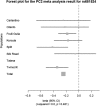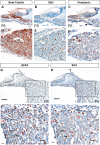Salt-inducible kinase 3, SIK3, is a new gene associated with hearing
- PMID: 25060954
- PMCID: PMC4222365
- DOI: 10.1093/hmg/ddu346
Salt-inducible kinase 3, SIK3, is a new gene associated with hearing
Abstract
Hearing function is known to be heritable, but few significant and reproducible associations of genetic variants have been identified to date in the adult population. In this study, genome-wide association results of hearing function from the G-EAR consortium and TwinsUK were used for meta-analysis. Hearing ability in eight population samples of Northern and Southern European ancestry (n = 4591) and the Silk Road (n = 348) was measured using pure-tone audiometry and summarized using principal component (PC) analysis. Genome-wide association analyses for PC1-3 were conducted separately in each sample assuming an additive model adjusted for age, sex and relatedness of subjects. Meta-analysis was performed using 2.3 million single-nucleotide polymorphisms (SNPs) tested against each of the three PCs of hearing ability in 4939 individuals. A single SNP lying in intron 6 of the salt-inducible kinase 3 (SIK3) gene was found to be associated with hearing PC2 (P = 3.7×10(-8)) and further supported by whole-genome sequence in a subset. To determine the relevance of this gene in the ear, expression of the Sik3 protein was studied in mouse cochlea of different ages. Sik3 was expressed in murine hair cells during early development and in cells of the spiral ganglion during early development and adulthood. Our results suggest a developmental role of Sik3 in hearing and may be required for the maintenance of adult auditory function.
© The Author 2014. Published by Oxford University Press.
Figures




References
-
- Lenoir M., Shnerson A., Pujol R. Cochlear receptor development in the rat with emphasis on synaptogenesis. Anat. Embryol. (Berl) 1980;160:253–262. - PubMed
-
- Spoendlin H. The innervation of the outer hair cell system. Otol. Neurotol. 1982;3:274–278. - PubMed
-
- Viljanen A., Era P., Kaprio J., Pyykkö I., Koskenvuo M., Rantanen T. Genetic and environmental influences on hearing in older women. J. Gerontol. A Biol. Sci. Med. Sci. 2007;62:447–452. - PubMed
-
- Karlsson K.K., Harris J.R., Svartengren M. Description and primary results from an audiometric study of male twins. Ear. Hear. 1997;18:114–120. - PubMed
Publication types
MeSH terms
Substances
Grants and funding
LinkOut - more resources
Full Text Sources
Other Literature Sources
Molecular Biology Databases
Research Materials
Miscellaneous

